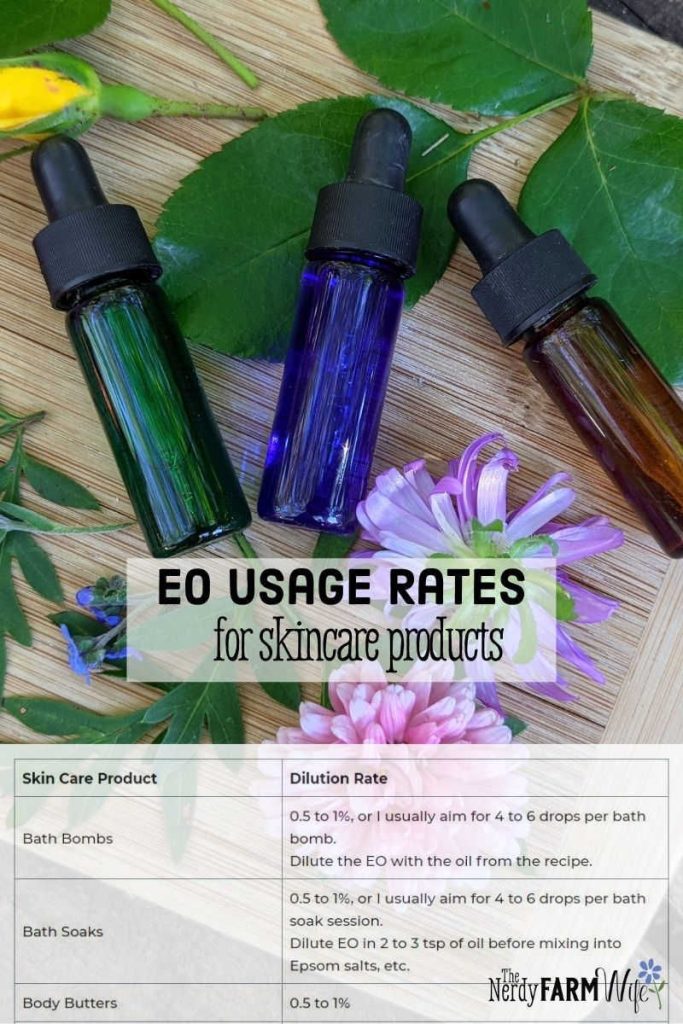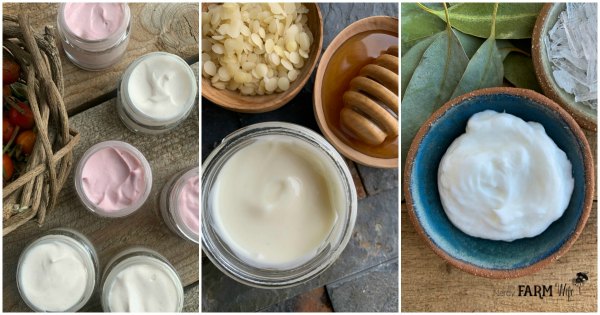Essential Oil Dilution Chart + Amounts to Use in Skin Care
Learn how much essential oil to use when making lip balm, bath bombs, salves, lotions, creams, and other skin care products.
Includes a dilution chart and helpful product reference table, plus answers to frequently asked questions!
Today, I’m sharing a couple of charts plus general guidelines from my personal notes that I constantly reference when creating natural skin care recipes for my published print books, eBooks, and courses.
If you’ve ever wondered how much essential oil to use in a bath bomb, lip balm, salve, or other DIY skin care recipe, then this article will be a helpful reference!
For cold process soapmaking, be sure to check out my article:
30 Essential Oils for Soapmaking + Printable Chart (cold process)
Essential Oil Dilution Chart
Most herbalists and many home hobbyists measure out essential oils by the drop when making salves, balms, and such for personal use, and follow standardized rates of dilution. The following chart is a handy reference to help you determine the correct amount to use in your handmade herbal products.
(See the weight vs drops section further down in this article, if more precise consistency is required.)
| Amount of Product | 0.5% | 1% | 2% | 3% | 4% |
| 0.5 oz (15 ml) | 1 drop | 3 drops | 6 drops | 9 drops | 12 drops |
| 1 oz (30 ml) | 3 drops | 6 drops | 12 drops | 18 drops | 24 drops |
| 2 oz (60 ml) | 6 drops | 12 drops | 24 drops | 36 drops | 48 drops |
| 3 oz (90 ml) | 9 drops | 18 drops | 36 drops | 54 drops | 72 drops |
| 4 oz (120 ml) | 12 drops | 24 drops | 48 drops | 72 drops | 96 drops |
| 7 oz (210 ml) | 21 drops | 42 drops | 84 drops | 126 drops | 168 drops |
| 8 oz (240 ml) | 1/4 tsp | 1/2 tsp | 1 tsp | 1 1/2 tsp | 2 tsp |
Some Quick Safety Tips
Essential oils are wonderful, but very powerful substances! Some have low usage rates – such as clove, cinnamon, bay rum, peru balsam, and ylang ylang, or might not be suitable for certain uses or persons.
Do not ingest, and never apply undiluted essential oils to your skin as they can cause sensitization and adverse reactions. I recommend wearing gloves when handling essential oils that might easily spill on your skin, and don’t let young kids handle the bottles or have easy access to them.
If you’re pregnant, nursing, on medication, or have any health questions or concerns, consult with a qualified healthcare provider before handling or using essential oils. Avoid working with essential oils when closed in a small area with pets, especially cats, as they can’t metabolize essential oils in the same way as humans.
Recommended Reading & Sources:
- Bell, Kristen Leigh. Holistic Aromatherapy for Animals.
- Purchon, Nerys and Lora Cantele. The Complete Aromatherapy & Essential Oils Handbook for Everyday Wellness.
- Tisserand, Robert and Rodney Young. Essential Oil Safety, Second Edition.
- Wormwood, Valerie Ann. The Complete Book of Essential Oils & Aromatherapy.
Essential Oil Usage Rate per Product Type
These are the general rates of essential oils (EO) that I use when creating various skin care products.
The suggested amounts reflect my slightly conservative approach to using essential oils on my sensitive and allergy-prone family members, plus the most current recommended IFRA rates. Sometimes I vary a bit higher or lower than these numbers in practice. My personal preference is to leave products unscented when making for kids under 2, and for those with sensitive skin, eczema, or allergies.
| Skin Care Product | Dilution Rate |
| Bath Bombs | 0.5 to 1%, or I usually aim for 4 to 6 drops per bath bomb. Dilute the EO with the oil from the recipe. |
| Bath Soaks | 0.5 to 1%, or I usually aim for 4 to 6 drops per bath soak session. Dilute EO in 2 to 3 tsp of oil before mixing into Epsom salts, etc. |
| Body Butters | 0.5 to 1% |
| Deodorants | 0.5 to 1% |
| Hair Products, Beard Oils/Balms | up to 1% |
| Headache Oil or Salve | 3 to 4% |
| Lip Balms | 0.5 to 1% |
| Lotion Bars | 0.5 to 1% |
| Lotions & Creams – for face, sensitive skin | 0.5% |
| Lotions & Creams – for ages 2 to 6 | up to 0.5% |
| Lotions & Creams – for body | 1% for everyday use |
| Massage Oil | 1% (or 2% for more localized oils, such as for back pain) |
| Salve – for extra sensitive skin, or kids | 0.5% |
| Salve – for everyday use | 1 to 2% |
| Salve – for aches & pains, spot treatment | 3 to 4% |
| Soap – cold process | 1 to 5% (use EO Calc & weight of oils in recipe) |
| Soap – melt & pour | 0.5 to 2.5% (use EO Calc & weight of base) |
I’ve purposely left this article free from essential oil affiliate links, but have especially enjoyed using essential oils from Mountain Rose Herbs, Eden Botanicals, and Plant Therapy for skin care products. For soapmaking, I buy larger-sized bottles from places such as Bramble Berry, Bulk Apothecary, Wholesale Supplies Plus & New Directions Aromatics. (Be cautious buying cheap oils from Amazon – there are many synthetic fragrance oils that are being fraudulently sold as essential oils there!)
Essential oils are concentrated natural scents that are distilled or extracted from flowers, herbs, trees, and other plants. Fragrance oils are manmade scents – they are composed of a wide array of synthetic aromatic chemicals but sometimes contain aromatic elements from nature too. Essential oils are considered a natural product, while fragrance oils are not.
Essential Oils and Kids, Pregnancy
Here are some excellent links to read, regarding the use of certain essential oils with kids, and during pregnancy.
Robert Tisserand’s guidelines for using peppermint & eucalyptus essential oil on kids
List of essential oils to avoid using on children under age 10 (Plant Therapy’s website)
National Association for Holistic Aromatherapy, information on pregnancy & nursing
Weight VS Drops
Professional crafters who sell their products are encouraged to use weight instead of drops when working with essential oils. Droppers can vary widely in how large or small the size of the drops they dispense are, leading to each new batch of lotion, cream, etc. turning out slightly different. You’ll need a small accurate scale that measures in grams. (I use and love a small jeweler’s scale, purchased from LotionCrafter.)
To figure amount of EO to use, add up the total weight of ingredients in your recipe/formula and multiply it by the recommended dilution rate percentage.
For example, let’s say you have a lotion recipe whose total ingredient weights add up to 100 grams (3.5 oz). It’s a daily use lotion for a healthy adult and you want to use a 1% essential oil dilution rate.
Take 100 grams x 0.01 (another way to write 1%), which equals: 1
You will use 1 gram of essential oil in your 100 grams of lotion, for a 1% dilution rate.
Alternatively, if designing your own formula, just pre-account for the essential oil rate. For example, the oils, water, emulsifier, preservative would equal 99%, allowing 1% room for essential oils, in order to total 100%. That works too!
As an herbalist who no longer sells product, I personally use both weight and drops (though favor drops to better fine tune the light scent of my creations.)
Learn More
Want to learn more about making safe, natural, and effective handmade skincare?
You may enjoy these popular products, designed for naturally-minded beginners and home crafters:




